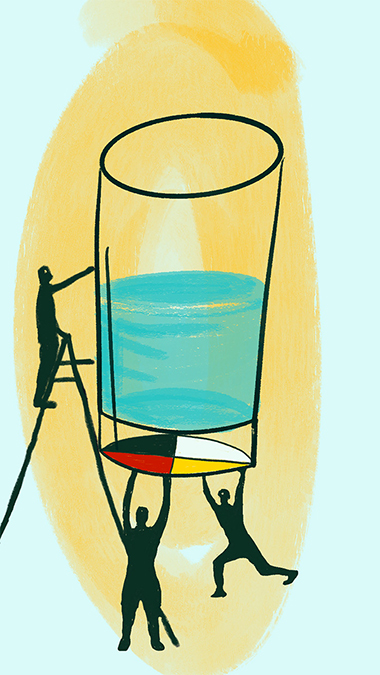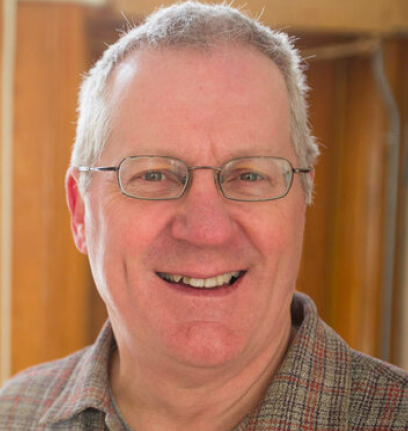
Water Heroes
First Nation water treatment plant operators keep water flowing and their communities safe

Dr. Bob Patrick
Associate Professor, Geography and Planning, University of Saskatchewan
It was a rainy day in July when I entered the Muskowekwan First Nation Band Office. I was cleaning the mud off my shoes, when I heard "You must be Bob, welcome to Muskowekwan!: the working committee are in the council room". I looked up at the smiling face of the community's water treatment plant operator.
Arriving at this Treaty 4 First Nation was about to become a re-education for me. My well-rehearsed source water protection PowerPoint was soon to be irrelevant to the reality of potable water service on this, and other, First Nation communities.
My presentation began by explaining the rationale for protecting a drinking water source – human health, reduced treatment plant challenges, and environmental sustainability. The Muskowekwan working committee members then explained what water meant to them – water as medicine, respect for the land, life-giving spirit of water, responsibility to future generations, respect for ancestors, and more. For me, this was an entirely new perspective.
Next, I began to explain the conventional, Western-science, approach to drinking water protection supported by government regulations, scientific literature, and my own academic research. Starting with the standard image of a glass of crystal-clear drinking water, my PowerPoint illustrations explained the multi-barrier approach to safe drinking water. Images of pristine water reservoirs surrounded by vegetation buffers, tidy farm-yard fencing, a modern water treatment plant, homes connected to a piped water distribution system, and white-coated technicians testing water samples – "The multi-barrier approach", I declared, "is what you need". This, I explained, was the 'source to tap' approach to safe drinking water.
Humbly, and respectfully, the response came: "...but Bob, our water system doesn't look like that". Clearly, it was time for me to become the listener, not presenter, as my First Nations water education began.
The committee then took me on a tour to show me that on-reserve, houses were not connected to the water treatment plant and that there was no piped-water distribution system. Instead, a tanker truck delivered water, year-round, to every home on the reserve. I heard how many of the households were overcrowded, making several truck deliveries per week necessary. I also learned that their water was delivered to an aging water cistern buried next to each home and I saw where, hidden by a snowdrift, a the edge of a cistern had been crushed by a tanker. These cisterns are concrete tanks exposed to freeze-thaw conditions, often cracked and susceptible to leakage, infiltration, and contamination. The water truck fill hoses are exposed to contamination both on the truck and when dragged along the ground to the cistern.
There were many other challenges too, with spring flooding, and summer grass fires that threatened community water wells. Land use activities beyond the control of the First Nation community -- such as potash mining, agriculture, and railroads added more tough issues. I learned quickly that 'source to tap' was very different, and more complex, for a First Nation community.
Perhaps the greatest challenge is faced by the water treatment plant (WTP) operator. Imagine being solely legally responsible for producing safe drinking water from well-water you wouldn't even dip your toes in. Imagine that hours from now your elders and kids will be drinking that treated water. Now, imagine being on-call for that job 20 hours/day. On most reserves in Canada, including Muskowekwan, WTP operators are constantly repairing their aging water treatment plants, and the chemicals they need are always rising in price. Further, the older technology in many water treatment plants is a poor match for the raw water quality they are meant to treat. Against all this, the WTP operator is a community member holding the moral and ethical responsibility for producing safe drinking water for their community members.
The First Nation WTP operator is expert in water chemistry, mechanical and electrical repairs and maintenance, workplace safety, financial management, human resources, administration, and more. To be a WTP operator on-reserve involves massive responsibility and time commitment. For these reasons, operators are in short supply in First Nations communities. The issue is also complicated by Ottawa's funding formula that pays a First Nation WTP operator less salary than in nearby municipalities, causing retention problems. Many First Nation WTP operators have no trained back-up person resulting in little, or no, opportunity to take holiday away from the reserve.
My experience at Muskowekwan First Nation was followed by presentations of Source Water Protection Plans at regional water conferences in Edmonton and Saskatoon, with the Muskowekan operator leading with an account of his own community's experience.
First Nation WTP operators perform heroic work and commit themselves daily to produce safe drinking water for their family and community. I have been fortunate to be educated by these highly skilled people and made aware of their ingenuity in solving technical problems, resilience in the face of institutional barriers, and adaptability to environmental conditions. For this -- and for the cue to correct my PowerPoint illustrations -- I am grateful.
Find out more: Awume, O., Patrick, R., & Baijius, W. (2020). Indigenous perspectives on water security in Saskatchewan, Canada. Water, 12(3), 810. https://doi.org/10.3390/w12030810
